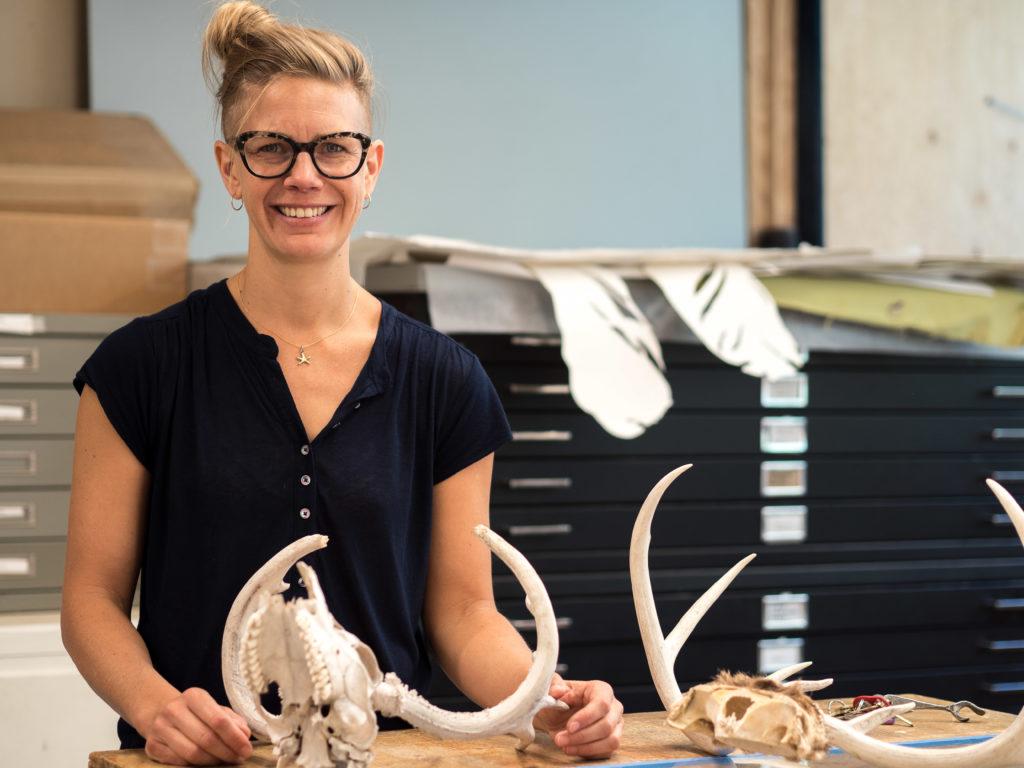Candace Mettle
mettleca@grinnell.edu
Professor Lee Emma Running, studio art, has received a 10,000 dollar grant from the Iowa Arts Council for her artistry with deer bones. Running began her art career as a hand papermaker, but after an apprenticeship with famed artist Tim Barrett at the University of Iowa, Running began to recognize the historical and traditional importance of bone as material. Recently, Running has been using roadkill she finds within Poweshiek County to spark a conversation about public uses of land, and relationships between humans and land, humans and violence and humans and animals.
“Iowa is farmed more than any other state in this union,” Running said. “There is farmed land within feet of our rivers, highways. … The physical dirt [in Iowa] is so valuable that there is almost no public land in the state. Part of what’s interesting to me in this project is that I started finding these bones because the only places that I can walk for miles are waterways and roadsides and ditches. You start to realize how many deer are killed in these spaces.”
As Running noticed the stark metaphor of the proximity of killed animals to cultivated and industrial lands, she kept the bones she found. She puts chicken wire over the bones to ensure that the bones will not be dragged away by scavengers such as insects and coyotes. After a sterilization process that includes hydrogen peroxide, Running sands the bones to a finish and polishes them. Then she carves out patterns, and within them, along with the interior chamber, Running applies 24 karat gold. Running has also established a relationship with Conrad Environmental Research Area (CERA) to notify her of newfound dead deer within the area to aid her in her art.
Aside from the spatial closeness of animals, Running remarked on the physical similarities of deer to humans as further inspiration for her work. Starting this week, with Jack Meggers, another Iowa Arts Council Fellowship recipient, Running will put her fellowship to work with a film at CERA, where a new deer has been found. Preliminary film work has been done with help from students Lydia James and Phoebe Schreckinger, both ’19, over the summer.
“Lee is an incredible artist and mentor — watching her collection come to life this summer in the clips that we made was super powerful,” Schreckinger said in an email to The S&B.
Similarly, James found the experience to be worth the extensive hours in providing them with a larger lens with which to view art and creation.
“I wouldn’t trade all the ankle-deep mud-wading, the tick bites, mysterious other bug bites, lugging massive tripods through prairie grass or hours of filming clouds and dead animals in various states of decay for the world,” James said in an email to The S&B. “I think the greatest gift Lee has given me, especially from our work this summer, is a new lens through which to view the world. This is the power she possesses as an artist and a human. I have a completely different work ethic and attitude as an artist after working with Lee this past year.”
Lee herself sees the film to be a means to explore the relationship between the human body and that of animals like the deer.
“Part of what I’m interested with this film is comparing my own body to the body of a deer,” Running said. “A mature deer pelvis is about the size of a 125-pound woman’s pelvis… If you put a human vertebra next to [a deer] vertebrae, it will almost be identical. There’s something powerful to me in how we relate to wildness and thinking about these animals that are like us. When I started to figure that out, it really felt even more powerful.”
The application process for the fellowship was extensive, beginning with a preliminary proposal featuring work that they find representative of their artistry, a full proposal if the preliminary is received well and two additional rounds of vetting. Running had applied once before but got rejected. However, after receiving feedback from the board on her initial application, Running made sure to tailor her second proposal based on their remarks, which are public records.
“I think it just serves as a reminder to always apply again,” Running said. “I think that’s a thing that many people forget to do with granting is that when you get rejected, write back and say if there is any feedback that you can give me that was super helpful because every grant is specific.”
Running also praised the Iowa Arts Council and other organizations, such as the Des Moines Art Center and the College’s Faulconer Gallery, for making art accessible. Most places are free of charge, or at least offer discounts and special days for students, children and senior citizens. As a result, it helps establish and make it known that, as Running said, culture happens here in Iowa and not only in New York City.
“Art has such an amazing impact in making a state livable, making it a state where people want to live, and Iowa has a deep problem of migration,” Running said. “People get a great education here and they leave. Art provides a place for people to be [and] continues to allow people to occupy public space. I think it’s really important that we have art for inspiration, but I think it’s really important to continue to have ways for the public to be connected to culture [and] to realize that culture happens here. There’s active life, live culture, in Iowa, and it’s really important to remember that Iowa is a viable place to live.”





























































